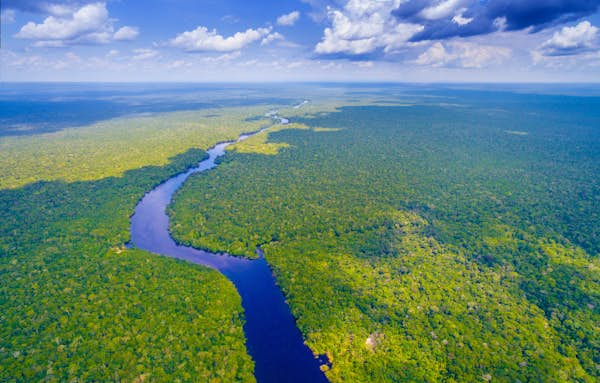With an estimated three football fields of the Amazon being cleared every minute, and a political administration that has so far overseen an eighty-five percent increase in forest fires across Brazil – with more than half of them in the Amazon region – the most bio-diverse habitat on our planet is in peril like never before.

What’s happening in the Amazon?
The French and German governments are calling the situation an ‘international crisis’ as they head to August’s G7 summit, and the Brazilian state of Amazonas has already declared a state of emergency over the thousands of deliberately-planned fires burning throughout the two million square miles of forest often referred to as ‘the lungs of the planet.’
While this sudden escalation in destruction has provoked disbelief and outrage online, there are plenty of people wondering what they can actually do to proactively help avert what many view as an ongoing global disaster. Here are a few ways in which you can help the Amazon rainforest.
Reduce consumption of damaging products
One way of helping the Amazon rainforest is to reduce your consumption of some of the products that are driving the deforestation. It’s estimated that around eighty percent of deforestation in the Amazon is driven by cattle ranchers, who in turn are responding to the global desire for cheap beef. So consider cutting down on the steaks and burgers unless you’re sure they’ve been sustainably sourced.
After beef, soy is the next biggest driver of deforestation in the Amazon region. With the ongoing US-China trade war, Brazilian agribusiness has been expanding its already hugely lucrative and environmentally damaging production of soy beans. Around eighty percent of Amazonian soy beans are fed to livestock, such as cows and pigs, but they can also be found in consumable products such as tofu, cooking oil, and some meat substitutes.

Donate to reputable NGOs
If you’re looking to donate money to an NGO, then there are plenty of deserving recipients doing important work on the front-line of this environmental war. Kanindé, located in the Amazonian state of Rondônia, is a local NGO that provides on-the-ground support and protection for the many indigenous groups within the state.
You can also consider donating to the Instituto Socioambiental, another highly respected Brazilian NGO that has been instrumental in defending the rights of the country’s indigenous population and protecting the Amazon’s unique natural habitats.
To help reporters on the ground, you could make a donation to InfoAmazonia and Amazônia Real two non-profit news providers who report on human rights abuses and environmental crimes directly from the Amazon.
To help support those that are monitoring the ongoing crisis, you can donate money to IPAM (Instituto de Pesquisas Ambientais da Amazônia), which produces important maps, reports and initiatives that have positively impacted Brazilian public policy.
Imazon is another non-profit research institution that has promoted sustainable development in the Amazon region by publishing hundreds of scientific papers over the last 24 years, influencing decision-makers and public policy, as well as offering training in the fields of ecology, environmental law, rural planning and other key areas.
Get political
You can still make a difference without having to give away your money. There are plenty of petitions to sign, such as Change.org’s ‘Stop the burning of the Amazon rainforest!’ or Greenpeace’s ‘Save the Amazon and stand with the guardians of the forest.’ Another way to influence the decision makers near you is to write to your local political representative.

Travel with an eco-consciousness
Another way to support the Amazon is to visit the area by either booking with an eco-friendly tour operator or staying at one of the many sustainable hotels and lodges located within the jungle. Responsible tourism is one way that the Amazon’s inhabitants can boost employment, protect their habitats, and sustainably grow their economy.
Sumak Travel a registered ethical tour operator, provides a private thirty-hour river boat journey up the Rio Negro to a natural reserve where visitors can meet the indigenous people of Xixuau, go on guided forest hikes, and see a stunning array of local wildlife.
The Juma Amazon Lodge is a sustainably crafted solar-powered property nestled in the heart of the Amazon rainforest. With over 90 percent of their staff coming from the local area, the lodge provides field trips, eco-tours and educational lectures that ensure your stay has the most positive impact possible.
Situated within a 12,000 hectare private nature reserve in the north of Brazil’s Mato Grosso state, the Cristalino Lodge offers a combination of comfort and responsible tourism. Daily activities include forest trails, canoeing and visiting local conservation projects. All of the lodge’s bungalows make us of solar-heated water and bio-waste treatment.
